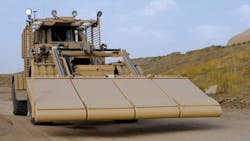Army orders ground-penetrating radar system from CSES for detecting hidden IEDs in $200.2 million deal
ABERDEEN PROVING GROUND, Md. – U.S. Army counter-land mine experts needed ground-penetrating radar systems to detect improvised explosive devices (IEDs) buried in roadways. They found their solution from Chemring Sensors and Electronics Systems (CSES) in Dulles, Va.
Officials of the Army Contracting Command at Aberdeen Proving Ground, Md., announced a $200.2 million order to CSES on Monday to develop and build Husky Mounted Detection System (HMDS) kits, spare parts, maintenance and training.
The HMDS is a counter-IED system able to detect underbelly IEDs and antitank land mines buried in primary and secondary roads. As a result, the HMDS is vital to route clearance packages (RCP). The system is a combination of the CSES VISOR 2500 ground-penetrating radar and the Husky vehicle from Critical Solutions International Inc. in Carrollton, Texas.
The HMDS helps the Army quickly clear roadways of anti-tank mines, roadside bombs, and other IEDs. The CSES VISOR 2500 ground-penetrating radar detects metallic and non-metallic explosive hazards, pressure plates, and antitank mines. It combines advanced real-time automatic-target-recognition algorithms, integrated metallic and non-metallic threat detection, automatic precision marking, and software in a ruggedized, supportable package.
CSES’s multi-panel high-performance VISOR GPR system functions on manned, blast-resistant vehicles to provide rapid ability to scope out anti-vehicle land mines and other explosive hazards on main supply routes and additional open areas as needed, CSES officials say.
CSES’s ground-penetrating radar and an optional metal detector, when mounted on manned, blast-resistant vehicles, provides a rapid ability to scope out anti-vehicular land mines or any other type of buried explosive hazard.
CSES’s VISOR 2500 ground-penetrating radar is designed for buried mine and similar explosives detection using ultra-wideband ground-penetrating radar arrays and automatic target recognition. The system uses ultra-wide-bandwidth impulses, has a high signal to clutter ratio, low radar cross-section, is lightweight, and offers low power consumption, CSES officials say.
For more information contact CSES online at https://c-s-i.com/husky, or the Army Contracting Command-Aberdeen Proving Ground at https://acc.army.mil/contractingcenters/acc-apg.

John Keller | Editor-in-Chief
John Keller is the Editor-in-Chief, Military & Aerospace Electronics Magazine--provides extensive coverage and analysis of enabling electronics and optoelectronic technologies in military, space and commercial aviation applications. John has been a member of the Military & Aerospace Electronics staff since 1989 and chief editor since 1995.

